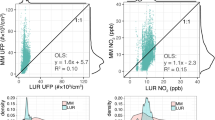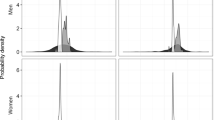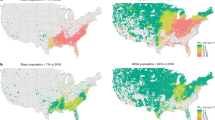Abstract
Despite substantial attention toward environmental tobacco smoke (ETS) exposure, previous studies have not provided adequate information to apply broadly within community-scale risk assessments. We aim to estimate residential concentrations of particulate matter (PM) from ETS in sociodemographic and geographic subpopulations in the United States for the purpose of screening-level risk assessment. We developed regression models to characterize smoking using the 2006–7 Current Population Survey—Tobacco Use Supplement, and linked these with air exchange models using the 2007 American Housing Survey. Using repeated logistic and log-linear models (n=1000), we investigated whether household variables from the 2000 United States census can predict exposure likelihood and ETS-PM concentration in exposed households. We estimated a mean ETS-PM concentration of 16 μg/m3 among the 17% of homes with non-zero exposure (3 μg/m3 overall), with substantial variability among homes. The highest exposure likelihood was in the South and Midwest regions, rural populations, and low-income households. Concentrations in exposed households were highest in the South and demonstrated a non-monotonic association with income, related to air exchange rate patterns. We provide estimates of ETS-PM concentration distributions for different subpopulations in the United States, providing a starting point for communities interested in characterizing aggregate and cumulative risks from indoor pollutants.
This is a preview of subscription content, access via your institution
Access options
Subscribe to this journal
Receive 6 print issues and online access
$259.00 per year
only $43.17 per issue
Buy this article
- Purchase on Springer Link
- Instant access to full article PDF
Prices may be subject to local taxes which are calculated during checkout

Similar content being viewed by others
References
Bohac D., Hewett M.J., Fitzgerald J.E., and Grimsrud D. Measured change in multifamily unit air leakage and airflow due to air sealing and ventilation treatments. Thermal Performance of the Exterior Envelopes of Whole Buildings XI International Conference. Clearwater Beach, FL, USA, December 2–7 2007 (2007).
California EPA. Health Effect of Exposure to Environmental Tobacco Smoke. Office of Environmental Hazard Assessment, California Environmental Protection Agency, (1997).
Centers for Disease Control and Prevention. (2006) The health consequences of involuntary exposure to tobacco smoke: a report of the Surgeon General, US Dept. of Health and Human Services, Centers for Disease Control and Prevention, Coordinating Center for Health Promotion, National Center for Chronic Disease Prevention and Health Promotion, Office on Smoking and Health: Atlanta, GA.
Chan W.R., Nazaroff W.W., Price P.N., Sohn WD, and Gadgil A.J. Analyzing a database of residential air leakage in the United States. Atmos Environ (2005): 39: 3445–3455.
Chahine T. Modeling Variability in Environmental Exposures and Health Risks for Community-based Risk Assessment. Doctoral Dissertation, Harvard University, Boston, MA (2010).
Datta G.D., Subramanian S.V., Colditz G.A., Kawachi I., Palmer J.R., and Rosenburg L. Individual, neighborhood, and state-level predictors of smoking among U.S. Black women: a multilevel analysis. Soc Sc Med (2006): 63: 2034.
Diamond R., Feustel H., and Matston N. Energy efficient ventilation for apartment buildings. Available: http://epb.lbl.gov/publications/, (1996).
Dockery D.W., and Spengler J.D. Personal exposure to respirable particulates and sulfates. J Air Pollut Control Assoc (1981): 31 (2): 153–159.
Jenkins R.A, Maskarinec M.P., Counts R.W., Caton J.E., Tomkins B.A., and Ilgner R.H. Environmental tobacco smoke in an unrestricted smoking workplace: area and personal exposure monitoring. J Exp Anal Environ Epidemiol (2001): 5: 369–380.
Jenkins R.A., Palausky A., Counts R.W., Bayne C.K., Dindal A.B., and Guerin M.R. Exposure to environmental tobacco smoke in sixteen cities in the United States as determined by personal breathing zone air sampling. J Exp Anal Environ Epidemiol (1996): 4: 473–502.
Klepeis N.E. An introduction to the indirect exposure assessment approach: modeling human exposure using microenvironmental measurements and the recent national human activity pattern survey. Environ Health Perspect (1999): 107 (S2): 365–374.
Klepeis N.E., Apte M.G., Gundel L.A., Sextro R.G., and Nazaroff W.W. Determining size-specific emission factors for environmental tobacco smoke particles. Aerosol Sci Technol (2003): 37 (1): 780–790.
Klepeis N.E., and Nazaroff W.W. Modeling residential exposure to secondhand tobacco smoke. Atmos Environ (2006): 40: 4393–4407.
Leaderer B.P. Assessing exposures to environmental tobacco smoke. Risk Anal (1990): 10 (1): 19–26.
Mannino D.M., Caraballo R., Benowitz N., and Repace J. Predictors of cotinine levels in children: data from the third national health and nutrition examination survey. Chest (2001): 120: 718–724.
Marano C., Schober S., Brody D., and Zhang C. Secondhand tobacco smoke exposure among children and adolescents: United States, 2003–2006. Pediatrics (2009): 124 (5): 1299–1305.
Martin P, Heavner D.L., Nelson P.R., Maiolo K.C., Risner C.H, Simmons P.S., Morgan W.T., and Ogden MW. Environmental tobacco smoke (ETS): a market cigarette study. Environ Int (1997): 23 (1): 75–90.
Max W., Sung H.Y., and Shi Y.L. Who is exposed to secondhand smoke? Self-reported and serum cotinine measured exposure in the U.S., 1999–2006. Int J Environ Res Public Health. (2009): 6 (5): 1633–1648.
Myatt T.A., Minegishi T., Allen J.G., and MacIntosh D.L., et al. Control of asthma triggers in indoor air with air cleaners: a modeling analysis. Environ Health (2008): 7: 43–56.
Nazaroff W.W., and Singer B.C. Inhalation of hazardous air pollutants from environmental tobacco smoke in U.S. residences. J Exp Anal Environ Epidemiol (2004): 14: S71–S77.
Osypuk T.L., Kawachi I., Subramanian S.V., and Acevedo-Garcia D. Are state patterns of smoking different for different racial/ethnic groups? An application of multilevel analysis. Public Health Rep (2006): 121: 563–576.
Ozkaynak H., Xue J., Spengler J., Wallace L., Pellizzari E., and Jenkins P. Personal exposure to airborne particles and metals: results from the Particle TEAM study in Riverside, California. J Exp Anal Environ Epidemiol (1996): 6 (1): 57–78.
Price P.N., Shehabi A., and Chan R. Indoor-Outdoor Air Leakage of Apartments, Commercial Buildings, California Energy Commission, PIER Energy-Related Environmental Research Program. CEC-500–2006–111. (2006).
Rasbash J., Browne W., Goldstein H., Yang M., Plewis I., and Healy M., et al A user's guide to MLwiN, Center for Multilevel Modelling, Institute of Education, University of London: London, (2002).
Repace J. Respirable particles and carcinogens in the air of Delaware hospitality venues before and after a smoking ban. J Occup Environ Med (2004): 46 (9): 887–905.
Repace J.L. Exposure to secondhand smoke. Exp Anal, In: Ott, Steinemann, Wallace Taylor and Francis Group: Boca Raton, FL, (2007) pp. 201–235.
Repace J.L., Hyde J.N., and Brugge D. Air Pollution in Boston bars before and after a smoking ban. BioMed Central Public Health (2006): 6: 266 . doi:10.1186/1471-2458-6-266.
Shavers V.L., Faga P., Jouridine Alexander L.A., Clayton R., Doucet J., and Bauzconde-Garbanati L. Workplace and home smoking restrictions and racial/ethnic variation in the prevalence and intensity of current cigarette smoking among women by poverty status, TUS-CPS 1998–1999 and 2001–2002. J Epidemiol Comm Health (2006): 60 (SupplII): 34–43.
Shavers V.L., Lawrence D., Fagan P., and Gibson J.T. Racial/ethnic variation in cigarette smoking among the civilian U.S. population by occupation and industry, TUS-CPS 1998–1999. Prev Med (2005): 41: 597–606.
US Census Bureau. Geographic Areas Reference Manual. Available: http://www.census.gov/geo/www/cen_tract.html, (2000).
US Department of Commerce, Census Bureau. National Cancer Institute and Centers for Disease Control and Prevention Co-Sponsored Tobacco Use Supplement to the Current Population Survey (2006–07): http://riskfactor.cancer.gov/studies/tus-cps/, (2008).
US Department of Housing and Urban Development, Office of Policy Development and Research. Codebook for the American Housing Survey, Public Use File: 1997 and later. Available: http://www.huduser.org/Datasets/ahs/AHS_Codebook.pdf, (2009).
US EPA. Respiratory health effects of passive smoking lung cancer and other disorders. Office of Research and Development, Office of Health and Environmental Assessment, (EPA/600/6-90/006F) (1992).
US EPA, Office of Air and Radiation. Air Quality Trends, Available: http://www.epa.gov/airtrends/pm.html, (2008).
Xu M.D., Nematollahi M., Sextro R.G., Gadgil A.J., and Nazaroff W.W. Deposition of tobacco smoke particles in a low ventilation room. Aerosol Sci Technol (1994): 20 (2): 194–206.
Zartarian V.G., and Schultz B.D. EPA human exposure research on assessing cumulative risk in communities. J Exp Sci Environ Epidemiol. (2010): 20 (4): 351–358.
Acknowledgements
This research was supported by EPA Student Services Contract #EP09D000560. We gratefully acknowledge Dr. Andrew Geller and Dr. Daniel Vallero of EPA's Office of Research and Development, National Exposure Research Laboratory, for providing technical review of the paper.
Author information
Authors and Affiliations
Corresponding author
Rights and permissions
About this article
Cite this article
Chahine, T., Schultz, B., Zartarian, V. et al. Modeling geographic and demographic variability in residential concentrations of environmental tobacco smoke using national data sets. J Expo Sci Environ Epidemiol 21, 646–655 (2011). https://doi.org/10.1038/jes.2011.12
Received:
Accepted:
Published:
Issue Date:
DOI: https://doi.org/10.1038/jes.2011.12
Keywords
This article is cited by
-
Development of a multidimensional housing and environmental quality index (HEQI): application to the American Housing Survey
Environmental Health (2022)
-
Correlates of Secondhand Tobacco Smoke Exposure Among Individuals with a History of Substance Use and/or Psychiatric Disorders Participating in a Tobacco Treatment Program in Vancouver, Canada
Community Mental Health Journal (2014)
-
The effects of indoor environmental exposures on pediatric asthma: a discrete event simulation model
Environmental Health (2012)



